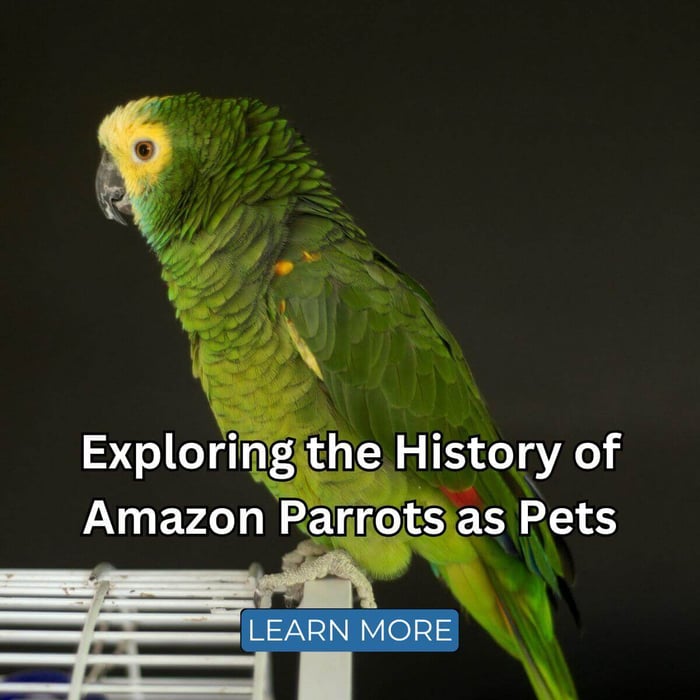Lovebirds as Pets: Everything You Need to Know
There's something truly special about keeping lovebirds as pets. These tiny parrots, bursting with colour and personality, aren't just pets - they're little bundles of joy that bring life and laughter into a home. Whether they're chattering away, playing with their favourite toy, or snuggling up with their chosen companion (yes, that might just be you!), lovebirds have a way of making every day feel brighter. If you've ever wondered what it's like to share your life with one of these affectionate birds, you're in for a treat.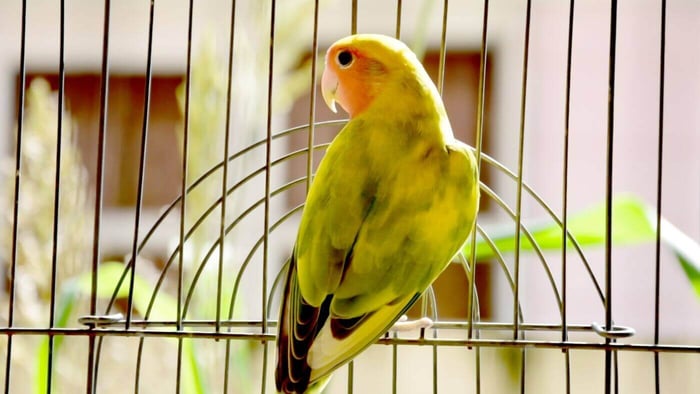
Beyond their loving nature, lovebirds are incredibly smart. They enjoy problem-solving, can mimic sounds, and thrive on interactive play. Their playful antics make them fascinating to watch and even more rewarding to bond with.
In this guide, we'll explore what makes lovebirds such special pets - from their unique traits and care needs to the different species you can welcome into your home. Whether you're drawn to the bright personality of a Peach-Faced Lovebird or the gentle nature of a Fischer's Lovebird, each variety has its own charm.
Types of Lovebirds and Their Characteristics
Lovebirds come in a variety of colours, sizes, and temperaments, making them a diverse group of small parrots. There are nine species of lovebirds, but the three most commonly kept as pets are the Peach-Faced Lovebird, Fischer's Lovebird, and the Black Masked Lovebird. Each species has its own unique characteristics that appeal to different types of owners.
Peach-Faced Lovebird
The Peach-Faced Lovebird (Agapornis roseicollis) is one of the most popular species among pet owners. Recognised for its stunning pastel colours, this species has a warm peach hue on its face that blends into a bright green body. Some variations, such as the Lutino and Pied mutations, display even more striking colour combinations. These lovebirds are social, playful, and often described as fearless. They thrive in interactive environments and enjoy playing with toys, climbing, and solving simple puzzles.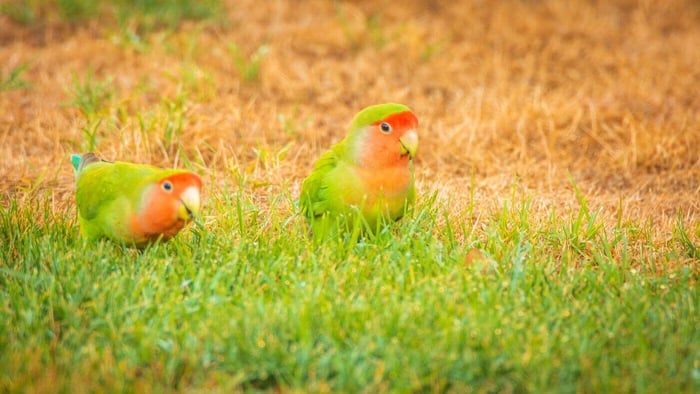
Fischer's Lovebird
Fischer's Lovebird (Agapornis fischeri) is another favourite among bird enthusiasts. Slightly smaller than the Peach-Faced variety, they are known for their bright green bodies, yellow-orange chests, and a striking red beak. Fischer's Lovebirds are highly energetic and curious, often engaging in playful activities throughout the day. They tend to be very active and require a lot of stimulation to stay happy and engaged. Due to their strong bonding instincts, they do well when kept in pairs but can also form close relationships with their owners if given enough attention.
Black Masked Lovebird
The Black Masked Lovebird (Agapornis personatus) is easily recognisable by its deep black facial mask, bright green body, and blue lower back and tail feathers. These birds are slightly more reserved compared to other lovebird species, making them a great choice for those who prefer a calmer companion. While they may take a bit more time to warm up to their owners, with patience and socialisation, they can become affectionate and loyal pets. They are highly intelligent and can learn tricks with consistent training.
Benefits of Keeping Lovebirds as Pets
Keeping lovebirds as pets comes with many benefits beyond companionship. Their small size makes them a great choice for those with limited space, and unlike larger parrots, they require minimal grooming. With the right setup, they're relatively easy to care for, making them ideal for both new and experienced bird owners.
When it comes to bonding, lovebirds are deeply social and thrive on interaction. Whether kept in pairs or as a single bird with plenty of human attention, they form strong attachments. With patience and consistent socialisation, they can become incredibly affectionate companions that recognise and respond to their owners.
Caring for Lovebirds - Housing, Diet, and Exercise
Caring for lovebirds requires a thoughtful approach to their housing, diet, and activity to ensure their well-being. A spacious cage with perches of varying sizes encourages natural movement and climbing. Additionally, providing toys and enrichment items keeps them mentally stimulated.
A balanced diet for lovebirds should consist of high-quality pellets, fresh fruits, and vegetables. Pellets should make up the majority of their diet, as they are specially formulated to meet their nutritional needs. Fresh produce, such as leafy greens, carrots, and berries, provides essential vitamins. It's important to avoid feeding lovebirds toxic foods such as avocado, chocolate, and caffeine. Fresh water should also be available at all times.
Exercise is a crucial part of a lovebird's well-being. These active birds need daily opportunities to stretch their wings, whether inside a spacious cage or during supervised out-of-cage time. Providing perches, interactive toys, and flight time helps keep them mentally and physically fit.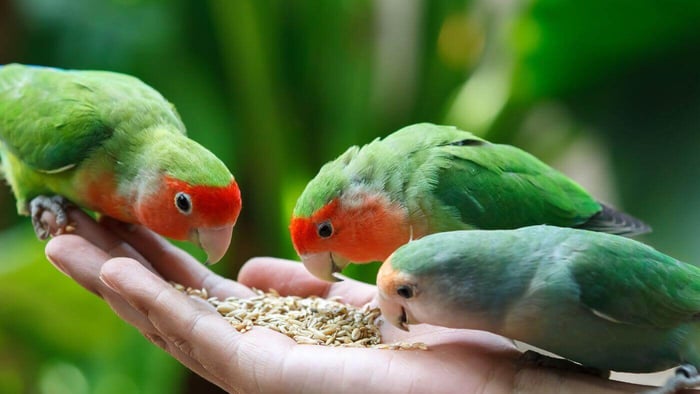
Common Health Issues in Lovebirds and How to Prevent Them
Like any pet, lovebirds can develop health issues if not properly cared for. Some common concerns include respiratory infections, feather plucking, nutritional deficiencies, and obesity.
Respiratory Infections
Lovebirds are prone to respiratory infections caused by poor ventilation, exposure to drafts, or airborne toxins like smoke and aerosol sprays. Symptoms include sneezing, wheezing, and nasal discharge. To prevent this, ensure proper cage placement away from direct drafts, clean their environment regularly, and avoid exposing them to harmful chemicals.
Feather Plucking
Feather plucking is often a result of stress, boredom, or an underlying medical issue. If a lovebird starts pulling out its feathers, it’s important to assess their environment and ensure they have plenty of mental stimulation, social interaction, and a proper diet. Veterinary consultation may be needed if the behaviour persists.
Nutritional Deficiencies
A diet lacking essential vitamins and minerals can lead to issues such as weak bones, dull feathers, and even metabolic disorders. Providing a varied diet with fresh produce, pellets, and occasional seeds can help prevent deficiencies. Calcium-rich foods like cuttlebone should also be offered.
Obesity and Liver Disease
Obesity in lovebirds is usually caused by overfeeding seeds and lack of exercise. A diet too rich in fatty foods can also contribute to liver disease. Ensuring a well-balanced diet, encouraging daily activity, and limiting high-fat treats can help maintain their overall health.
Regular veterinary check-ups, a proper diet, and a stimulating environment are key to preventing these health concerns and ensuring a long, happy life for your lovebird.
Bonding with Your Lovebirds - Socialisation and Training
Bonding with lovebirds is an enriching experience that requires patience, time, and consistency. Socialisation is crucial, as they thrive on interaction with their owners and other birds. To build a strong bond, spend time with them daily, talk to them softly, offer treats, and engage in gentle play. Over time, they will learn to trust you, and you'll witness their affectionate nature emerge.
Training lovebirds can also be rewarding. These intelligent birds can learn a variety of tricks and commands, which stimulate their minds and enhance their bond with you. Begin with simple commands like "step up" to encourage them to perch on your finger. Use positive reinforcement, such as treats and praise, to motivate them. Regular practice will reinforce their learning and aid in their overall socialisation.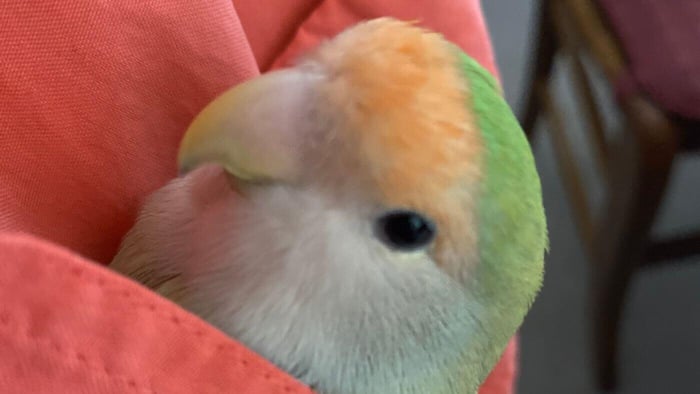
Lovebirds in Popular Culture - Movies, Books, and Art
Lovebirds have long been a symbol of devotion and romance, often appearing in art, literature, and even mythology. Their strong pair bonds have inspired love stories across cultures, and their vibrant appearance has made them a favourite subject in paintings and poetry. In modern media, lovebirds have been featured in children's books and animated films, further cementing their reputation as birds that embody love and companionship.
Conclusion - Why Lovebirds Make Wonderful Pets
In conclusion, lovebirds are extraordinary companions that offer a wealth of joy and affection to pet owners. Their vibrant colours and engaging personalities make them a delightful addition to any home. The bonds they form with their owners are truly special, characterised by loyalty, playfulness, and affection. As you have learned, lovebirds thrive on social interaction and require mental stimulation and physical activity to lead happy, healthy lives.
The benefits of keeping lovebirds as pets extend beyond their captivating appearance; their intelligence and ability to learn tricks provide endless entertainment and engagement. With proper care, including a balanced diet, spacious housing, and regular exercise, lovebirds can flourish in a loving environment. Their unique characteristics, such as their social nature and communicative behaviours, allow for a fulfilling relationship that enriches the lives of both the birds and their owners.
As you embark on the journey of keeping lovebirds, rest assured that these colourful companions will bring warmth and joy to your life. Whether you're captivated by their playful antics, their affectionate nature, or the beautiful songs they sing, lovebirds are sure to leave a lasting impression. By understanding their needs and nurturing the bond you share, you'll discover the true wonders of having lovebirds as pets, creating cherished memories that will last a lifetime.
FAQs
What are the most common types of lovebirds kept as pets?
The most popular types of lovebirds kept as pets are the Peach-Faced Lovebird, Fischer's Lovebird, and the Black Masked Lovebird. Each has unique traits and colours that appeal to different bird enthusiasts.
What kind of diet is best for lovebirds?
Lovebirds thrive on a balanced diet of high-quality pellets supplemented with fresh fruits and vegetables. Pellets should form the majority of their diet to meet their nutritional needs, while fresh produce like leafy greens and berries provides essential vitamins.
How much space and exercise do lovebirds need?
Lovebirds require a spacious cage with varied perch sizes to encourage natural movements and climbing. Daily opportunities for exercise are crucial, including time outside their cage in a safe, supervised environment to stretch their wings and interact with toys.
Can lovebirds be trained?
Yes, lovebirds are intelligent and can learn a variety of tricks and commands. Training should start with simple commands like "step up" and use positive reinforcement such as treats and praise. Regular interaction and practice are key to their learning and bonding.
What are some common health issues in lovebirds and how can they be prevented?
Common health issues include respiratory infections, feather plucking, nutritional deficiencies, and obesity. Preventive measures include ensuring a well-ventilated and clean living area, providing a balanced diet, regular social interaction, and mental stimulation, along with routine veterinary check-ups.

